Early Christian Symbolism on Roman Coins
Return to the main page. Return to Table 6 on the main page.
Coins of Table 6: AD 350-353: Coins issued by Magnentius as Augustus (350-353) and his brother Decentius as Caesar.
A substantial fraction of all ancient coins of Magnentius and Decentius are contemporary imitations. They are sometimes hard to distinguish from mint issues, but sometimes are smaller and cruder, with errors in the lettering and poor engraving. Some imitations are illustrated below.
Images are all proportional to their actual size.
Magnentius and Decentius issued AE types, of which these have Christian references
1) FEL TEMP REPARATIO, "galley" (Type 6.1)
2) FELICITAS ROMANORVM, emperor standing holding Victory and standard with chi-rho (Type 6.2)
3) two Victories holding a shield inscribed VOT/V/MVLT/X, sometimes with a Christian symbol (chi-rho or cross-rho) as a control mark above the shield
VICTORIA DD NN AVG ET CAES around (Type 6.3) (Type 6.3B was for Constantius II after Rome was recovered)
4) GLORIA ROMANORVM, emperor standing left holding Victory on globe and standard with chi-rho, small captives on either side (Type 6.4)
5) large chi-rho, SALVS DD NN AVG ET CAES around, on an AE1 (Type 6.5)
6) the same chi-rho design, but half size, an AE2 (Type 6.6)
7) FEL TEMP REPARATIO, emperor holds labarum with chi-rho (Type 6.7)
8) VICTORIA AVG ET CAES, emperor right with left foot on captive, holding standard with chi rho and branch (Type 6.8)
9) VICTORIA AVG LIB ROMANOR, Emperor holding standard with chi-rho, to right a kneeling and bound captive (Type 6.9)
Type 6.1. AE2. "galley"
FEL TEMP REPARATIO, Emperor in military dress standing left on galley
holding Victory on globe and standard with chi-rho. Victory wth rudder at stern
A in field left . There is only one mint (Trier) and variety [TRP or TRS]
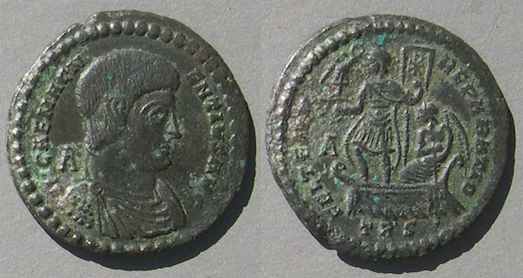
Magnentius.
23 mm. 5.25 grams. 6:00.
Struck 19 Jan. 350 - Spring 351.
at Trier with mintmark TRS.
RIC Trier 260.
Type 6.2. AE2. FELICITAS REIPVBLICE
emperor standing left holding Victory on globe and labarum with chi-rho

Magnentius.
22 mm. 5.54 grams. 6:00.
Struck Jan. 350-Spring 351.
at Lugdunum with mintmark RSLG
RIC Lyons 112.

Magnentius
22 mm. 5.43 grams. 12:00.
Struck Jan. 350-Spring 351.
at Trier with mintmark TRS<crescent upwards>
RIC VIII Trier 266
Type 6.3. AE2. VICTORIAE DD NN AVG ET CAE(S)
Two victories holding shield/wreath between them inscribed VOT V MVL X with chi-rho above [some have a cross-rho instead]
The Christian symbol is not part of the type; the type is more commonly seen without one.
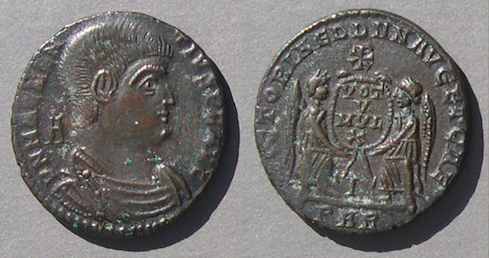
Magnentius
22-20 mm. 4.23 grams. 6:30.
Struck 351-353
at Arles (Arelate) with mintmark PAR.
RIC Arles 184.
chi-rho above shield

Magnentius.
22 mm. 2.54 grams. 12:00.
Struck 351-352
at Amiens (Ambianum) with mintmark AMB.
RIC Amiens 20
cross-rho above shield
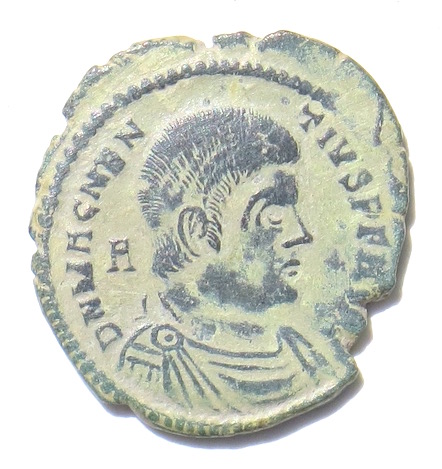

Magnentius
24-23 mm. 4.31 grams. 6:30.
Struck 350-353
at Lugdunum (Lyons)
RIC Lyons 140
chi-rho above shield
This basic two-victories type is, by far, the most common type for Decentius, but there are no examples with a chi-rho or cross-rho illustrated here.
Type 6.3B: VOT/XXX instead of VOT/V/MVLT/X
and the legend VICT DD NN AVG ET CAES instead of VICTORIAE DD NN AVG ET CAE(S)


Constantius II, after reclaiming Rome from Magnentius.
21-20 mm. 4.70 grams. 6:00
Very similar to the above, but
VOT/XXX instead of VOT/V/MVLT/X
with chi-rho above shiield
and
VICT DD NN AVG ET CAES
Struck only at Rome.
RIC Rome 252
Only for Constantius II.
This "XXX" type was issued only for Constantius II. A very similar type with "VOT V MVLT X" was issued for Gallus. All varieties have the chi-rho above the shield.
Type 6.4. Large AE2. GLORIA ROMANORVM
Emperor holding Victory on globe crowning him, holding labarum with chi-rho in left, captives to his left and right
A in field right

Magnentius
24-23 mm. 3.92 grams.
Struck at Aquileia with mintmark AQS<dot>
RIC Aquileia 148.
(RIC says "Common" but in fact scarce or rare.)
Type 6.5. AE1. SALVS DD NN AVG ET CAES, large chi-rho with alpha and omega on either side. (Discussed on the main page.)
The "AVG ET CAES" refers to Magnentius, the AVGustus, and his brother, Decentius, whom he elevated to the rank of CAESar.
The type is also issued for Decentius.

Magnentius.
27 mm. 8.84 grams. 6:00.
Struck 352
at Trier with mintmark TRS
(in modern Germany, near its border with Luxembourg)
Bust of Magnentius right, head bare
DN MAGNEN-TIVS PF AVG
RIC Trier 318
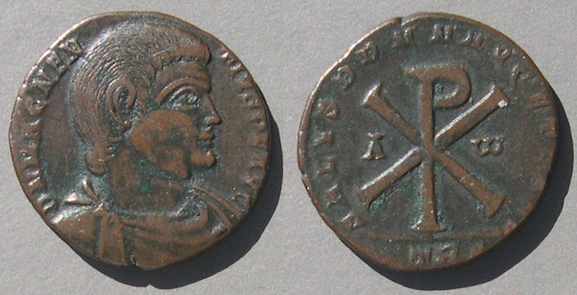
Magnentius
24 mm. 7.28 grams, 6:00.
Struck 352
at Trier with mintmark TRS
but much more realistic style than the above example.
RIC Trier 320

Magnentius
26 mm. 9.80 grams. 6:00
Much like the above, but with the omega tilted and the letter chi outlined.

Magnentius
25 mm. 7.67 grams. 6:00
Mintmark: AMB<palm>
from the Amiens mint
RIC Amiens 43
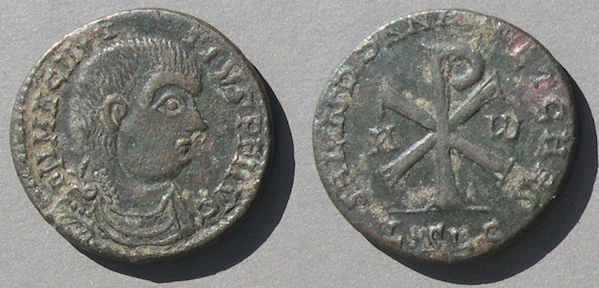
Magnentius (imitation)
25-24 mm. 8.43 grams. 6:00.
Mintmark: LSLG
A high-quality imitation of a coin of Lugdunum
with a cruder portrait than official issues.
The line between "official" and "imitation" can be very fine in this era. Some are far too crude to be official, but this one is near the borderline and I think it is on the unofficial side.

Decentius
23 mm. 6.88 grams. 6:30.
DN DECENTI-VS NOB CAES
Struck Spring 351-18 August 353
at Lugdunum (Lyons) with mintmark PSLG<dot>
RIC Lyons 159.

Decentius
22 mm. 5.70 grams. 11:00.
DECENTI-VS FORT CAES
(an unusal title--FORT for FORTissimus = Champion)
Struck 352-353
Mintmark off the flan, but possibly struck at Trier--FORT in the legend is only at Trier and Aquileia.


Decentius
27-25 mm. 7.71 grams. 6:00
DN DECENTIVS CAESAR
Struck 351-353
Mintmark: PAR
RIC Arles 191
Note for collectors: This desirable type is common for Magnentius, although it is rarely in the highest condition. Contemporary imitations are about as common as official coins, so the style can vary from excellent and official to crude imitations with poor lettering. Is is less common for Decentius and the best Magnentius pieces are larger by a few milimeters than the largest Decentius pieces, which rarely come with full flan.
Cut-down coins. The large denomination was almost discontinued after emperor Jovian (364 AD) and replaced by smaller coins except for a few AE1 examples of Valentinian and even fewer of Valens. The smallest are called by modern collectors AE4s. By the end of the century most AE was small and the larger denominations had been demonetised. Probably near and after 400 AD the larger coins were melted or cut down to make current denominations.
 Cut down Magnentius. 11 mm. 1.06 grams.
Cut down Magnentius. 11 mm. 1.06 grams.
Amiens mint
as can be seen from the lucky preservation of "AM" from the mintmark.
Only the lower left of the chi-rho remains.
The "N" on the obverse is in that postion only for Magnentius, not for Decentius. (Decentius legends break after the I, Magnentius after the N.)

Cut down Magnentius chi-rho piece.
15 mm. 1.77 grams.
We know it is not Decentius (who was Caesar, not Augustus) because of the obverse legend AVG ending at 5:00, which is very weak.

Decentius, cut down.
9 mm. 0.55 grams.
The ending of the obverse legend indicates Decentius rather than Magnentius.
The upper right quadrant of the chi-rho is clear.
Note for Collectors: Late Roman pieces of this approximate size are found by the thousands in England (and perhaps elsewhere). Most are junk or tiny FEL TEMP REPARATIO fallen-horseman imitations, but if you look through enough of them you will find some cut-down earlier coins and some of those just might be chi-rhos of Magnentius or Decentius. So, it is fair to say examples as clear as these are rare or maybe even very rare, but they are not whole original coins and therefore are not valuable. I don't think dealers even offer them. To find them you may need to plow through the thousands of coins at an English coin fair yourself.
Type 6.6. AE2. SALVS DD NN AVG ET CAES, large chi-rho with alpha and omega on either side.
This is the same type as the large "double maiorina" as above, but in a smaller denomination, the "maiorina."

Magnentius
20 mm. 4.58 grams. 11:30.
Struck Spring 351-353
at Arles with mintmark SAR
RIC Arles unlisted with this mintmark, but
similar to 201 for size and type and 188 1nd 194 for mintmark but the wrong size.
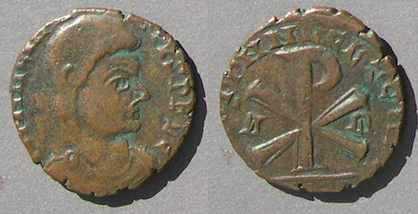
Magnentius.
17 mm. 2.75 grams. 5:00.
mintmark too weak to make out.
This is probably an ancient imitation. It is small and crude.
Note, for example, the upside-down omega, and AG for AVG.
 Decentius.
Decentius.
20 mm. 3.32 grams. 6:00.
DN DECENTIVS NOB CAES
Struck Spring 351-18 August 353
at Lyons (Lugdunum) with mintmark RSLG
RIC Lyons 164
Failmezger 447 this coin.
The lettering is mostly good and the much of the design is well done, but the odd ear and the tilted omega indicate this may be an ancient imitation, although the regularity of most of the design makes it likely to be an official coin.
Note for collectors: This smaller denomination is much less common than the larger Type 6.5 and almost never comes in excellent condition.
Type 6.7. AE2. FEL TEMP REPARATIO, emperor holds labarum with chi-rho
 Magnentius
Magnentius
22.5 mm. 4.88 grams.
This type was not struck for Decentius, so it is dated before Decentius
Jan. 350-Spring 351.
RIC VIII Lugdunum (Lyons) 108 "R" (but I think R2 or rarer)
There are none of this type for Decentius.
Type 6.8. AE1-2. VICTORIA AVG ET CAES, Emperor in military dress right with left foot on captive, holding standard with chi rho and branch.
 Magnentius
Magnentius
25 mm. 4.55 grams.
Struck Sept. 351
[The chi rho is barely visible on this example.]
III in field left and a monogram in field right (looking somewhat like VAL ligate)
RIC VIII Siscia 318, "R" (319 is for Decentius, also "R")
Type 6.9. AE2. VICTORIA AVG LIB ROMANOR, Emperor holding standard (labarum) with chi-rho, holding olive branch in left, to right a kneeling and bound captive.
 Magnentius
Magnentius
22 mm. 3.75 grams.
[This is the smaller type with this legend. The larger type, c. 24 mm, has an eagle on the banner, not a chi rho.]
[The chi rho is barely visible on this example.]
Struck Jan. - May 350.
RIC Rome 193 "before 3 June 350"
There are none of this type for Decentius.
Continue with a page with some later types.
Return to the previous page with types of Vetranio.
Return to Table 6 on the main page.



















 Cut down Magnentius. 11 mm. 1.06 grams.
Cut down Magnentius. 11 mm. 1.06 grams.





 Magnentius
Magnentius Magnentius
Magnentius